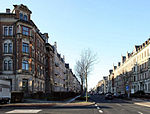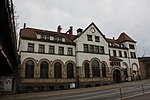Chemnitz

Chemnitz (German: [ˈkɛmnɪts] (listen); from 1953 to 1990: Karl-Marx-Stadt [kaʁlˈmaʁksˌʃtat] (listen), lit. 'Karl Marx City') is the third-largest city in the German state of Saxony after Leipzig and Dresden. It is the 28th largest city of Germany as well as the fourth largest city in the area of former East Germany after (East) Berlin, Leipzig and Dresden. The city is part of the Central German Metropolitan Region, and lies in the middle of a string of cities sitting in the densely populated northern foreland of the Elster and Ore Mountains, stretching from Plauen in the southwest via Zwickau, Chemnitz and Freiberg to Dresden in the northeast. Located in the Ore Mountain Basin, the city is surrounded by the Ore Mountains to the south and the Central Saxon Hill Country to the north. The city stands on the Chemnitz River (progression: Zwickauer Mulde→ Mulde→ Elbe→ North Sea), which is formed through the confluence of the rivers Zwönitz and Würschnitz in the borough of Altchemnitz. The name of the city as well as the names of the rivers are of Slavic origin. Chemnitz is the third largest city in the Thuringian-Upper Saxon dialect area after Leipzig and Dresden. The city's economy is based on the service sector and manufacturing industry. Chemnitz University of Technology has around 10,000 students. Chemnitz will be the European Capital of Culture of 2025.
Excerpt from the Wikipedia article Chemnitz (License: CC BY-SA 3.0, Authors, Images).Chemnitz
Lohstraße, Chemnitz Zentrum
Geographical coordinates (GPS) Address Nearby Places Show on map
Geographical coordinates (GPS)
| Latitude | Longitude |
|---|---|
| N 50.833333333333 ° | E 12.916666666667 ° |
Address
Lohstraße 2
09111 Chemnitz, Zentrum
Saxony, Germany
Open on Google Maps










